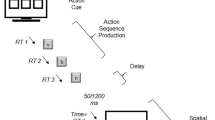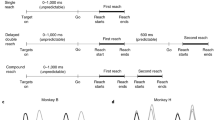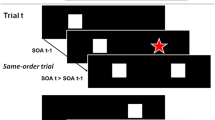Abstract
The capacity to acquire motor skills through repeated practice of a sequence of movements underlies many everyday activities. Extensive research in humans has dealt with the importance of spatial and temporal factors on motor sequence learning, standing in contrast to the few studies available in animals, particularly in nonhuman primates. In the present experiments, we studied the effect of the serial order of stimuli and associated movements in macaque monkeys overtrained to make arm-reaching movements in response to spatially distinct visual targets. Under different conditions, the temporal structure of the motor sequence was varied by changing the duration of the interval between successive target stimuli or by adding a cue that reliably signaled the onset time of the forthcoming target stimulus. In each condition, the extent to which the monkeys are sensitive to the spatial regularities was assessed by comparing performance when stimulus locations follow a repeating sequence, as opposed to a random sequence. We observed no improvement in task performance on repeated sequence blocks, compared to random sequence blocks, when target stimuli are relatively distant from each other in time. On the other hand, the shortening of the time interval between successive target stimuli or, more efficiently, the addition of a temporal cue before the target stimulus yielded a performance advantage under repeated sequence, reflected in a decrease in the latency of arm and saccadic eye movements accompanied by an increased tendency for eye movements to occur in an anticipatory manner. Contrary to the effects on movement initiation, the serial order of stimuli and movements did not markedly affect the execution of movement. Moreover, the location of a given target in the random sequence influenced task performance based on the location of the preceding target, monkeys being faster in responding as a result of familiarity caused by extensive practice with some target transitions also used in the repeated sequence. This performance advantage was most prominently detectable when temporal prediction of forthcoming target stimuli was optimized. Taken together, the present findings demonstrate that the monkey’s capacity to make use of serial order information to speed task performance was dependent on the temporal structure of the motor sequence.





Similar content being viewed by others
References
Albouy G, Ruby P, Phillips C, Luxen A, Peigneux P, Maquet P (2006) Implicit oculomotor sequence learning in humans: time course of offline processing. Brain Res 1090:163–171
Bengtsson SL, Ehrsson HH, Forssberg H, Ullén F (2004) Dissociating brain regions controlling the temporal and ordinal structure of learned movement sequences. Eur J Neurosci 19:2591–2602
Bortoletto Μ, Cook A, Cunnington R (2011) Motor timing and the preparation for sequential actions. Brain Cognit 75:196–204
Bowman EM, Aigner TG, Richmond BJ (1996) Neural signals in the monkey ventral striatum related to motivation for juice and cocaine reward. J Neurophysiol 75:1061–1073
Christie MA, Dalrymple-Alford JC (2004) A new rat model of the human serial reaction time task: contrasting effects of caudate and hippocampal lesions. J Neurosci 24:1034–1039
Cohen A, Ivry RI, Keele SW (1990) Attention and structure in sequence learning. J Exp Psychol Learn Mem Cogn 16:17–30
Deffains M, Legallet E, Apicella P (2010) Modulation of neuronal activity in the monkey putamen associated with changes in the habitual order of sequential movements. J Neurophysiol 104:1355–1369
Destrebecqz A, Cleeremans A (2003) Temporal effects in sequence learning. In: Jiménez L (ed) Attention and implicit learning. John Benjamins Publishing Company, Amsterdam, pp 181–213
Dominey PF (1998) A shared system for learning serial and temporal structure of sensorimotor sequences? Evidence from simulation and human experiments. Cogn Brain Res 6:163–172
Frensch PA, Miner CS (1994) Effects of presentation rate and individual differences in short-term memory capacity on an indirect measure of serial learning. Memory Cogn 22:95–110
Garraux G, McKinney C, Wu T, Kansaku K, Nolte G, Hallett M (2005) Shared brain areas but not functional connections controlling movement timing and order. J Neurosci 25:5290–5297
Ghilardi MF, Moisello C, Silvestri G, Ghez C, Krakauer JW (2009) Learning of a sequential motor skill comprises explicit and implicit components that consolidate differently. J Neurophysiol 101:2218–2229
Gibbon J, Church RM (1990) Representation of time. Cognition 37:23–54
Grosbras MH, Leonards U, Lobel E, Poline JB, LeBihan D, Berthoz A (2001) Human cortical networks for new and familiar sequences of saccades. Cereb Cortex 11:936–945
Hikosaka O, Nakamura K, Sakai K, Nakahara H (2002) Central mechanisms of motor skill learning. Curr Opin Neurobiol 12:217–222
Kawashima R, Tanji J, Okada K, Sugiura M, Sato K, Kinomura S, Inoue K, Ogawa A, Fukuda H (1998) Oculomotor sequence learning: a positron emission tomography study. Exp Brain Res 122:1–8
Keele SW, Mayr U, Ivry R, Hazeltine E, Heuer H (2003) The cognitive and neural architecture of sequence representation. Psychol Rev 110:316–339
Lee D, Quessy S (2003) Activity in the supplementary motor area related to learning and performance during a sequential visuomotor task. J Neurophysiol 89:1039–1056
Marcus DJ, Karatekin C, Markiewicz S (2006) Oculomotor evidence of sequence learning on the serial reaction time task. Memory Cogn 34:420–432
Matsumoto N, Hanakawa T, Maki S, Graybiel AM, Kimura M (1999) Role of nigrostriatal dopamine system in learning to perform sequential motor tasks in a predictive manner. J Neurophysiol 82:978–998
Matsuzaka Y, Picard N, Strick PL (2007) Skill representation in the primary motor cortex after long-term practice. J Neurophysiol 97:1819–1832
Miyashita K, Rand MK, Miyachi S, Hikosaka O (1996) Anticipatory saccades in sequential procedural learning in monkeys. J Neurophysiol 76:1361–1366
Moisello C, Crupi D, Tunik E, Quartarone A, Bove M, Tononi G, Ghilardi MF (2009) The serial reaction time task revisited: a study on motor sequence learning with an arm-reaching task. Exp Brain Res 194:143–155
Nixon PD, Passingham RE (2000) The cerebellum and cognition: cerebellar lesions impair sequence learning but not conditional visuomotor learning in monkeys. Neuropsychologia 38:1054–1072
Procyk E, Dominey PF, Amiez C, Joseph JP (2000) The effects of sequence structure and reward schedule on serial reaction time learning in the monkey. Cogn Brain Res 9:239–248
Ravel S, Sardo P, Legallet E, Apicella P (2006) Influence of spatial information on responses of tonically active neurons in the monkey striatum. J Neurophysiol 95:2975–2986
Reed J, Johnson P (1994) Assessing implicit learning with indirect tests: determining what is learned about sequence structure. J Exp Psychol Learn Mem Cogn 20:585–594
Remillard G, Clark JM (2001) Implicit learning of first-, second-, and third-order transition probabilities. J Exp Psychol Learn Mem Cogn 27:483–498
Schwarting RKW (2009) Rodent models of serial reaction time tasks and their implementation in neurobiological research. Behav Brain Res 199:76–88
Shidara M, Aigner TG, Richmond BJ (1998) Neuronal signal in the monkey ventral striatum related to progress through a predictable series of trials. J Neurosci 18:2613–2625
Stadler MA (1995) The role of attention in implicit learning. J Exp Psychol Learn Mem Cogn 21:674–685
Stadler MA, Neely CB (1997) Effects of sequence length and structure on implicit serial learning. Psychol Res 60:14–23
Ullén F, Bengtsson SL (2003) Independent processing of the temporal and ordinal structure of movement sequences. J Neurophysiol 90:3725–3735
Willingham DB (1998) A neuropsychological theory of motor skill learning. Psychol Rev 105:558–584
Willingham DB, Greenberg AR, Thomas RC (1997) Response-to-stimulus interval does not affect implicit motor sequence learning, but does affect performance. Memory Cogn 25:534–542
Acknowledgments
We thank Dr. I. Balansard for assistance with surgery. This research was supported in part by a grant from the French government (Action Concertée Incitative «Neurosciences Intégratives et Computationnelles») and by Centre National de la Recherche Scientifique.
Author information
Authors and Affiliations
Corresponding author
Rights and permissions
About this article
Cite this article
Deffains, M., Legallet, E. & Apicella, P. Importance of the temporal structure of movement sequences on the ability of monkeys to use serial order information. Exp Brain Res 214, 415–425 (2011). https://doi.org/10.1007/s00221-011-2839-0
Received:
Accepted:
Published:
Issue Date:
DOI: https://doi.org/10.1007/s00221-011-2839-0




